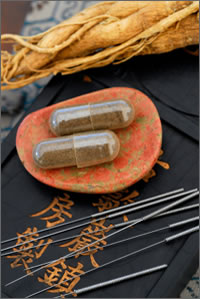Traditional Chinese Medicine – the bigger picture.
Traditional Chinese Medicine is a complete medical system. It has eight branches each of which has its own special part to play in promoting good health.
They are: Acupuncture, Chinese Herbal Medicine, Qi Gong, Massage, Moxibustion, Manipulation. Diet and Exercise
Acupuncture – As described in more detail on its own page, is the insertion of fine needles into the skin to disperse blockages and bring the patient’s energy flow into balance.
 Chinese Herbal Medicine – this is the prescription of herbs, pills, powders or tinctures made from different parts of plants, such as roots, stems, leaves, bark, seeds or flowers. The Chinese herbalist diagnoses the patient in the same way as an acupuncturist would but instead of using needles, prescribes a mixture of herbs carefully balanced to help that individual.
Chinese Herbal Medicine – this is the prescription of herbs, pills, powders or tinctures made from different parts of plants, such as roots, stems, leaves, bark, seeds or flowers. The Chinese herbalist diagnoses the patient in the same way as an acupuncturist would but instead of using needles, prescribes a mixture of herbs carefully balanced to help that individual.
Qi Gong – is an umbrella term that covers a vast array of Chinese exercises used to improve health, or for spiritual development . Tai chi is one form of qi gong which has become popular in the West. The therapy Buqi which I practise is a special type of qi gong healing. The qi gong exercises which support it are called Taiqiwuxigong and allow the patient to take charge of their health by doing their own daily practice.
Tui na - is Chinese theraputic massage. As with acupuncture and herbal medicine it looks at both the energetic and physical bodies, using touch to heal and relax.
Moxa – when we talk about ‘acupuncture treatment’ in the West we usually mean both acupuncture and moxibustion. Moxibustion is the burning of a herb, artemesia, on, or close to, the body. It is used alongside needles to warm our Qi when it is too cold, and also to nourish and regulate its flow.
Manipulation – this is usually known in the West as Osteopathy or Chiropractic.
 Diet – There are so many dietary ‘fads’ coming and going here in the West that people often end up feeling confused about what constitutes a healthy diet. In contrast basic dietary rules in China have not changed over thousands of years. Chinese dietary therapy does not follow a rigid regime and is adjusted according to a person’s age, build, health and living conditions. This diet has stood the test of time and is based on sound principles.
Diet – There are so many dietary ‘fads’ coming and going here in the West that people often end up feeling confused about what constitutes a healthy diet. In contrast basic dietary rules in China have not changed over thousands of years. Chinese dietary therapy does not follow a rigid regime and is adjusted according to a person’s age, build, health and living conditions. This diet has stood the test of time and is based on sound principles.
In order to get the most out of acupuncture or Buqi treatment it is very important to support your therapy with the proper diet and lifestyle.
According to TCM each food has a particular temperature and flavour. This means that whether a food is good or bad for a person is entirely dependent on that person’s constitution as described by their TCM diagnosis. Advice is given to the patient about how their diet could be modified to support their treatment.
Exercise – A different level of exercise is appropriate for each person. Regular and appropriate exercise is essential for the proper circulation of our energy. ‘Internal’ exercises such as tai chi or yoga are very beneficial for people who do not have enough energy to undertake Western-type exercises.

